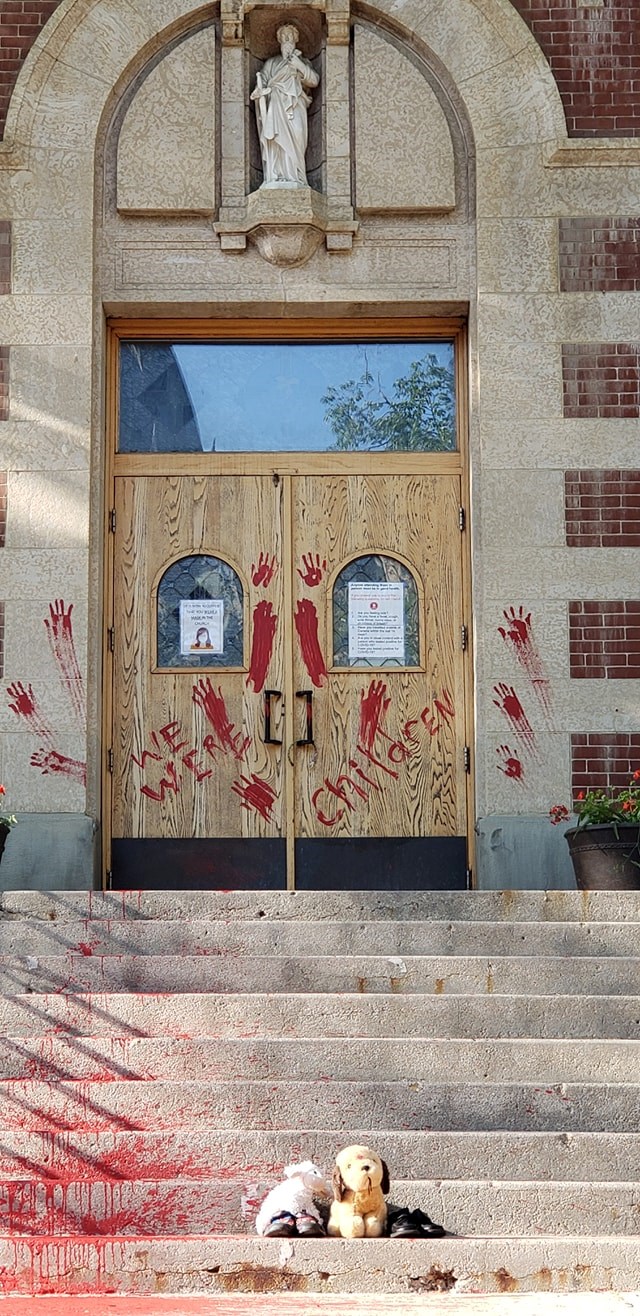A powerful image has made the rounds on social media in the days since the Cowessess First Nation announced the horrific discovery of as many as 751 unmarked graves, mostly containing the remains of Indigenous children, at the former site of a Saskatchewan residential school.
The photo, shot by Donna Heimbecker, shows the doors of the St. Paul’s Co-Cathedral in Saskatoon splattered in paint and smeared handprints, with the stunning message, scrawled in blood-red: “We Were Children.”
The reaction to such a provocative act generally followed the same predictable pattern you tend to see anytime a social protest movement makes its way into the spotlight. There are the vows of support, like the eyewitness on the scene who watched as the woman painted the doors of the Roman Catholic church in real time. “It was very solemn, and it was very peaceful and it was really beautiful,” Cathy Bohachik, who was raised Catholic and said she had never heard of the residential school system growing up, told the CBC.
Then there’s the other side of the coin, those who express their understanding of the rage burbling over across the country out of one side of their mouth only to disavow such acts of civil disobedience out of the other. You see it with practically every large-scale social resistance movement. We saw it during the civil rights battle of the 1960s; we saw it in Ferguson, Mo. after the 2015 death of Michael Brown; and we saw it more recently in Minneapolis, Minn. after the police killing of George Floyd. Inevitably, there’s a lot of handwringing and hot air wasted over the “right way” to protest, usually from those deeply entrenched in a system of power they stand to benefit the most from.
But let’s face it: paint washes off. It’s much harder to erase the blood and tears spilled by generations of marginalized people who, in this country at least, have watched for generations as their families, their communities and their identities have been ripped from them at the hands of a callous and self-serving government, a white majority fuelled by ignorance, and a complicit RCMP and Catholic Church (the latter, it should be noted, has yet to make any sort of formal apology for its role in operating residential schools, and continues to refuse to provide historical burial records).
It’s something I’ve been thinking a lot about since the remains of 215 Indigenous people, believed to be mostly children, were found at a former residential school in Kamloops in May, and we’ve watched as it seems like scores of Canadians are finally waking up to this country’s long history of oppression and systematic dismantling of our First Peoples.
To those non-Indigenous people, I ask a question we would all do well to be asking ourselves right now: what took you so long?
It’s great to see the collective outpouring of grief and solidarity with our Indigenous communities, but it shouldn’t have had to take hundreds of dead children to finally start paying attention. First Nations across Canada have for decades been speaking up about the children who simply vanished from their midst, and the legacy of that genocide—are we allowed to call it a genocide yet?—does not sit in some distant past; its effects and traumas continue to reverberate today, so if your heart aches for the children who never returned home from residential school, it should also ache for those who did.
Canadians have a long history of ignoring our problematic past and present of racialization and colonialism, rooted in a Victorian sense of politeness that would rather avoid tough conversations than face them head on. So if it takes a bit of protest and a lot of anger to provoke our non-Indigenous population into action that is inarguably long overdue, then so be it.
Martin Luther King Jr., a civil rights leader who has been whitewashed over the years into a symbol of gentle pacifism in order to better conform to white America’s acceptable notions of Black protest, named this kind of tone-policing as one of the greatest threats to Black advancement in his famous “Letter From a Birmingham Jail.”
“I have almost reached the regrettable conclusion that the Negro’s great stumbling block in his stride toward freedom is not the White Citizens’ Councilor or the Ku Klux Klanner, but the white moderate, who is more devoted to ‘order’ than to justice; who prefers a negative peace which is the absence of tension to a positive peace which is the presence of justice; who constantly says: ‘I agree with you in the goal you see, but I cannot agree with your methods of direct action’; who paternalistically believes he can set the timetable for another man’s freedom; who lives by a mythical concept of time and who constantly advises the Negro to wait for a ‘more convenient season.’”
What’s become clear in these past few harrowing weeks is, for Canada, we can no longer wait for a more convenient season, and that will inevitably require us to accept some inconvenient truths about this country we hold dear if we want to ensure a path to justice for the original inhabitants of this land.




